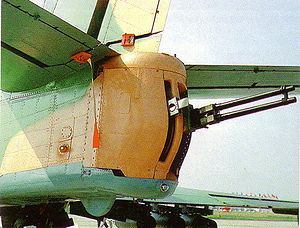Gryazev-Shipunov GSh-23
| GSh-23 | |
|---|---|
 | |
| Type | Automatic cannon |
| Place of origin | |
| Service history | |
| In service | 1965-present |
| Used by | See Users |
| Production history | |
| Designer | KBP Instrument Design Bureau |
| Designed | 1960s |
| Manufacturer | KBP Instrument Design Bureau |
| Variants | GSh-23L |
| Specifications | |
| Weight | 49.2 kg (GSh-23) 50 kg (GSh-23L) |
| Length | 1387 mm (GSh-23) 1537 mm (GSh-23L) |
| Barrel length | 1000 mm |
| | |
| Cartridge | 23x115mm AM-23 |
| Barrels | 2 |
| Action | Gast principle |
| Rate of fire | 3400-3600 rounds/min |
| Muzzle velocity | 715 m/s |
The Gryazev-Shipunov GSh-23 (ГШ-23) is a twin-barreled 23 mm automatic cannon developed in the Soviet Union, primarily for military aircraft use. It entered service in 1965, replacing the earlier Nudelman-Rikhter NR-23 cannon.
The GSh-23 works on the Gast Gun principle developed by German engineer Karl Gast of the Vorwerk company in 1916. It is a twin-barreled weapon in which the firing action of one barrel operates the mechanism of the other. It provides a much faster rate of fire for lower mechanical wear than a single-barrel weapon, although it cannot match the rate of fire of an electric Gatling gun like the M61 Vulcan. The Gast principle has been little used in the West, but was popular[citation needed] in the former Soviet Union on a variety of weapons.
The cannon comes in a basic GSh-23 variant, and the more popular GSh-23L (ГШ-23Л), differing mostly in adding a muzzle brake, lowering recoil force. This cannon was standard fit on late-model MiG-21 fighters (M, MF, SMT, bis), all variants of the MiG-23, the SOKO J-22 Orao, the HAL Tejas and IAR 93, and the tail turrets of the Tupolev Tu-22M 'Backfire' bomber and some late-model Tu-95s. In that application, it had the unusual ability to fire infrared flares and chaff rounds, allowing it to function as both a weapon and a dispenser of anti-missile countermeasures. It is also mounted on late small series Mi-24VP helicopters (in the NPPU-23 movable mounting) and Polish W-3WA Sokół helicopter in fixed mounting. The cannon was also used on cargo aircraft; specifically, Russian/Soviet Ilyushin Il-76 aircraft were designed to accommodate twin Gsh-23L's in a tail turret.[1] An Il-76M with just such a configuration could be seen at the 2002 Ivanovo airshow.[2]
Some 2nd generation MiG-21 models could carry the GSh-23L in an under-fuselage gondola designated the GP-9, carrying the cannon and 200 rounds of ammunition; this was replaced by a more streamlined semi-conformal installation in later variants. There are also several gun pods available for mounting on external hardpoints: UPK-23 for air-to-air use, with one or two fixed GSh-23 guns and 200-400 rounds of ammunition, and SPPU-22 pods with traversable barrels for strafing, from 0° to −30° (they were most often carried by the Su-17/-20/-22).
Users
References
- ↑ http://www.aviapress.com/viewonekit.htm?OKB-004
- ↑ http://www.foxbat.ru/maks/ivan/index.php?picid=ivanovo10
- Koll, Christian (2009). Soviet Cannon - A Comprehensive Study of Soviet Arms and Ammunition in Calibres 12.7mm to 57mm. Austria: Koll. p. 155. ISBN 978-3-200-01445-9.